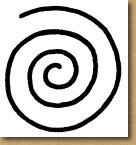
Go to: The Wanderings - Navaho Index
Now at this time some of the people returned to inhabit Pueblo Bonito and Aztec. They built their homes over the ancient houses. The Blue Bird Clan people went first to Pueblo Bonito, then they moved to Tse dez a', Under the Rock, across from Farmington. From there they moved to the mouth of Salt Canyon. Many seeds were found there, the seeds of many plants then plentiful in the country. The people discovered a rich land south of Shiprock, but they lived there for only a little over 5 years. Then they moved again to south of the Carrizos. They went over the pass, and settled in a cave.
They had the Calendar Stone with them. The medicine woman who kept this stone saw that the people had made a mistake. The people had been making pots that were coiled up like a snake. She saw that at the home of the Five Chiefs of the Winds their water jars were made of coiled snakes. They were the jars which contained the Chiefs of the Winds' medicine: the clouds and vapors, rain and lightnings. The people of the earth were not to copy the jars of the Five Chiefs of the Winds. This medicine woman saw in the Calendar Stone that the lives of all the people were threatened from above. So word was sent to all the people of what she had seen, and of their mistake. They were told that there would come a tribe to their land called the Dinae'e or Dîné. Now some of the people destroyed the pots that they had made; but others just laughed and said: "The wind never told me to make such jars, it was my own idea. I made the jars with my own hands. This has always been our country, and we shall do as we please in our own country."
The Blue Bird Clan people and the different Corn Clan people got together and destroyed their coiled pots. They took all the different kinds of beads and they put them in a big smooth jar, and with them they placed the flint stone, the two feathers of the giant birds, and the Calendar Stone. They placed this large jar on a rock which they had hollowed out; and they sealed it with four slabs of rock and pitch.
After they had done this the hail fell for 4 days, and through some of the hailstones were little young spruce trees. The hail became soft when it fell on those people who had listened to the warning; but the hard hail, and the little spruce trees, like arrows, destroyed those who would not listen. All those who were willing to leave the country were saved.
Now there were some people living at Aztec who were saved, and they were told to remember this story. And there were some people living near the South Mountain, which is called Tso dzil, and the Blue Bird Clan people and the Corn Clan people, who had moved southwest of the Carrizos, who were also saved; the rest were destroyed. Later, the Blue Bird Clan people on and near the Carrizos moved near Navaho Mountain and built their homes there.
There is a story about one of the men who left the party and followed the Chin Lee Wash until he came to the San Juan River. He got into a log that floated him down the river. He went ashore after a long time and he followed the river. He married a snake maiden. They returned to the foot of Navaho Mountain. They had born to them children. One of these children harmed another child of the tribe. The harm was like a snake bite. The people sent the family away.
note: There are both Hopi and Zuñi legends about the young man who traveled down the river In a log.
(Today, their descendants are the people who can dance with snakes, the people who hold the Snake Ceremony.) Then, while some of the people moved from the top of the Black Mountain and the country near there, others moved farther south and they built on the top of rocky mesas where the Hopi Villages are today. There is where they made their homes.

The Great Coil above the Square Tower House Ruin, Mesa Verde
The pictograph of the coil is the symbol of the Winds. The people had carved the coil in the rock in many places so that people would always remember this story and never make the mistake again.
Go to: The Wanderings - Navaho Index